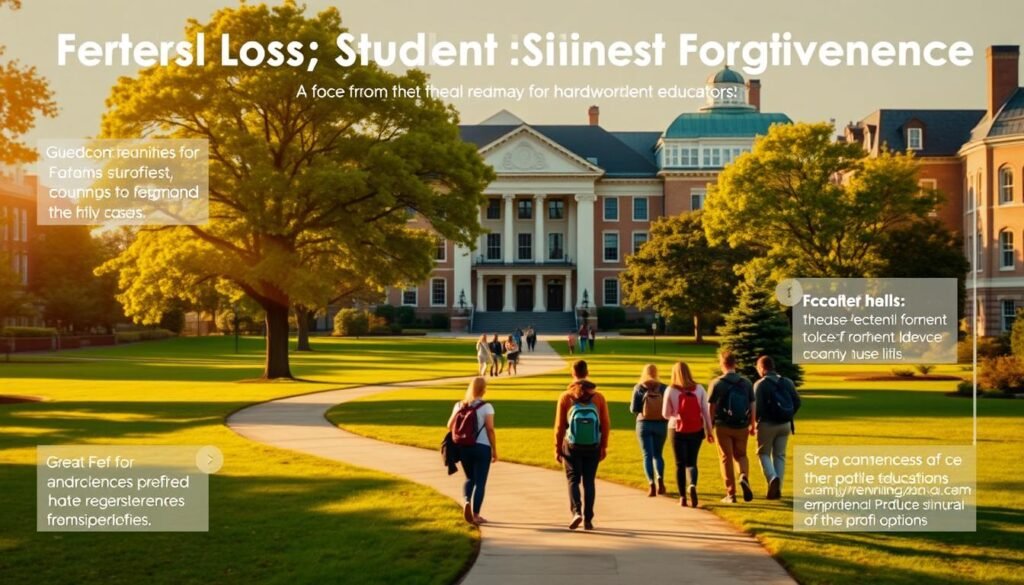
Path to federal loan forgiveness teachers USA

You came here for a clear path. Imagine walking into the staff lounge with a stack of forms and leaving with a plan that actually helps. That happened to Maria, a high school science teacher, when she learned which steps counted and which wasted time.
In this short guide, you get plain-English answers about what counts toward relief, how eligibility works, and what paperwork protects your progress. We focus on teacher-specific benefits so you can reduce what you owe and avoid common pitfalls.
You’ll find a friendly, step-by-step plan to download records, confirm service, and gather proof. The goal is practical tips you can act on between classes, not a long legal lecture.
By the end, you’ll have a checklist and pointers to free help if you want one-on-one support. Start here, take small steps, and keep your finances moving forward.
- Start here: Your roadmap to teacher loan forgiveness in the United States
- Understand your options: Teacher Loan Forgiveness and Public Service Loan Forgiveness
- federal loan forgiveness teachers USA: How to check your eligibility and documents
- Take action with confidence: Steps you can take today to move toward forgiveness
- Your next step toward forgiveness starts now
Start here: Your roadmap to teacher loan forgiveness in the United States
Begin by turning your payment history and employment records into proof you can actually use.
What “loan forgiveness” means for your federal student loans right now
“Loan forgiveness” means your remaining balance can be canceled after you meet specific service and payment rules. Right now, your most relevant options include Teacher Loan Forgiveness and Public Service Loan Forgiveness under a federal student framework.
The landscape is changing. Political moves and lawsuits put some programs at risk, so act now to protect your progress.

"Download your Federal Student Aid data and capture IDR payment history screenshots to preserve proof of qualifying months."
- Log in to your Federal Student Aid Dashboard and download the .txt data file for a time-stamped record.
- If you’re on an income-driven plan, follow IDR End of Payment Term → View IDR Progress → Payment History and take screenshots.
- Keep employment certifications ready and confirm job titles and dates with HR.
- Consider registering for an AFT student debt clinic—its updated curriculum offers educator-focused help.
Tip: Treat this as a living roadmap. Secure duplicate records, verify payment counts, and revisit this guide as rules shift.
Understand your options: Teacher Loan Forgiveness and Public Service Loan Forgiveness
Compare the targeted educator route and the broader public-service path so you can pick the best fit for your situation.
Teacher Loan Forgiveness eligibility: To qualify for the targeted forgiveness program you must be a highly qualified instructor who taught full‑time for five complete, consecutive academic years in a Title I‑eligible school or district listed in the Annual Directory of Designated Low‑Income Schools for Teacher Cancellation Benefits.
Also, you must not have had an outstanding balance on Direct or FFEL loans as of Oct. 1, 1998 (or on the date you received a later loan). Confirm your role and dates with HR before you count service years.

How much can be forgiven
Most qualifying teachers may receive up to $5,000. Certain highly qualified secondary math or science teachers and eligible special education teachers whose training matches the disabilities taught may receive up to $17,500.
PSLF basics for educators
Public Service Loan Forgiveness cancels remaining balances after you make qualifying payments while working full‑time for eligible public service employers. Many public school educators meet the employer test, but payment and employment certification must align.
Why present changes matter
The AFT warns of active threats to PSLF and income-driven rules from Project 2025 actions, lawsuits, and efforts targeting the department education. Document your payments and certifications now and follow curriculum updates from student debt clinics.
"Keep employment certifications and payment records archived so your progress remains verifiable if rules shift."
federal loan forgiveness teachers USA: How to check your eligibility and documents
Start by pulling your official records so you can see exactly which payments and service months count. This gives you a timestamped, authoritative view of your student accounts and supports any future application.

Download your federal student aid data and verify your payment history
From your Federal Student Aid Dashboard: click “View Details” under “My Aid,” then select “Download My Aid Data” to get the .txt file of your history. Save it with the date in a secure drive and repeat the export after major changes.
If you’re on an IDR plan, open “IDR End of Payment Term → View IDR Progress → Payment History.” Take clear screenshots of each payment section so you preserve qualifying months.
"Capture dated records now screenshots and the .txt file protect your progress if records change."
Confirm your teaching service: full-time, five consecutive years, and school listings
Gather employment docs that show full-time status and five complete, consecutive academic years. Verify your school appears in the Annual Directory for each claimed year.
- Keep certifications, contracts, and HR letters together.
- Cross-reference names, dates, and employer addresses with your My Aid Data file.
- If totals disagree, document discrepancies with screenshots before contacting the department education or your servicer.
Take action with confidence: Steps you can take today to move toward forgiveness
Start by securing dated proof of payments and service so the department can verify your claim.
Log in to studentaid.gov and secure your records for Department of Education review
Download your aid .txt file first. Save it with the date. Put a copy in cloud storage and one on an external drive.
Track your IDR progress and screenshots to protect your family’s financial health
Open View IDR Progress → Payment History and take clear screenshots. Note months in forbearance or deferment so you know which payments count.
Get support: Join a student debt clinic and explore free repayment tools
Register for an AFT student debt clinic the updated curriculum is practical and educator-focused. Try the Summer member tool to compare repayment paths.
- Keep a log of servicer errors with dates, names, and screenshots.
- Email debtclinic@aft.org with documents ready if you need help.
- Share your servicing story to inform policy fixes that help other families.
| Action | Why it matters | When to do it |
|---|---|---|
| Download .txt aid data | Speeds review by Department of Education | Today |
| Capture IDR payment history | Proves qualifying months for a forgiveness program | Monthly |
| Store copies in two places | Protects your records if a device fails | After each update |
| Join AFT clinic | Get step-by-step help using updated curriculum | When ready |
"Capture dated records now screenshots and the .txt file protect your progress if records change."
Your next step toward forgiveness starts now
Start with a ten-minute task: download your dated aid file, save screenshots, and organize documents for the path that fits your situation. These small steps make future reviews easier and faster.
Confirm employer eligibility, check your title and service dates, and list gaps so HR can supply precise records before you submit forms for the program you choose.
Add calendar reminders for annual IDR recertification and export fresh copies after any status change. Track your student loan status, submit forms when ready, and keep consistent records.
If you want help, sign up for a debt clinic session with your documents. Share this guide with a colleague working together keeps progress steady toward forgiveness.
If you want to know other articles similar to Path to federal loan forgiveness teachers USA you can visit the category Loans.






Leave a Reply